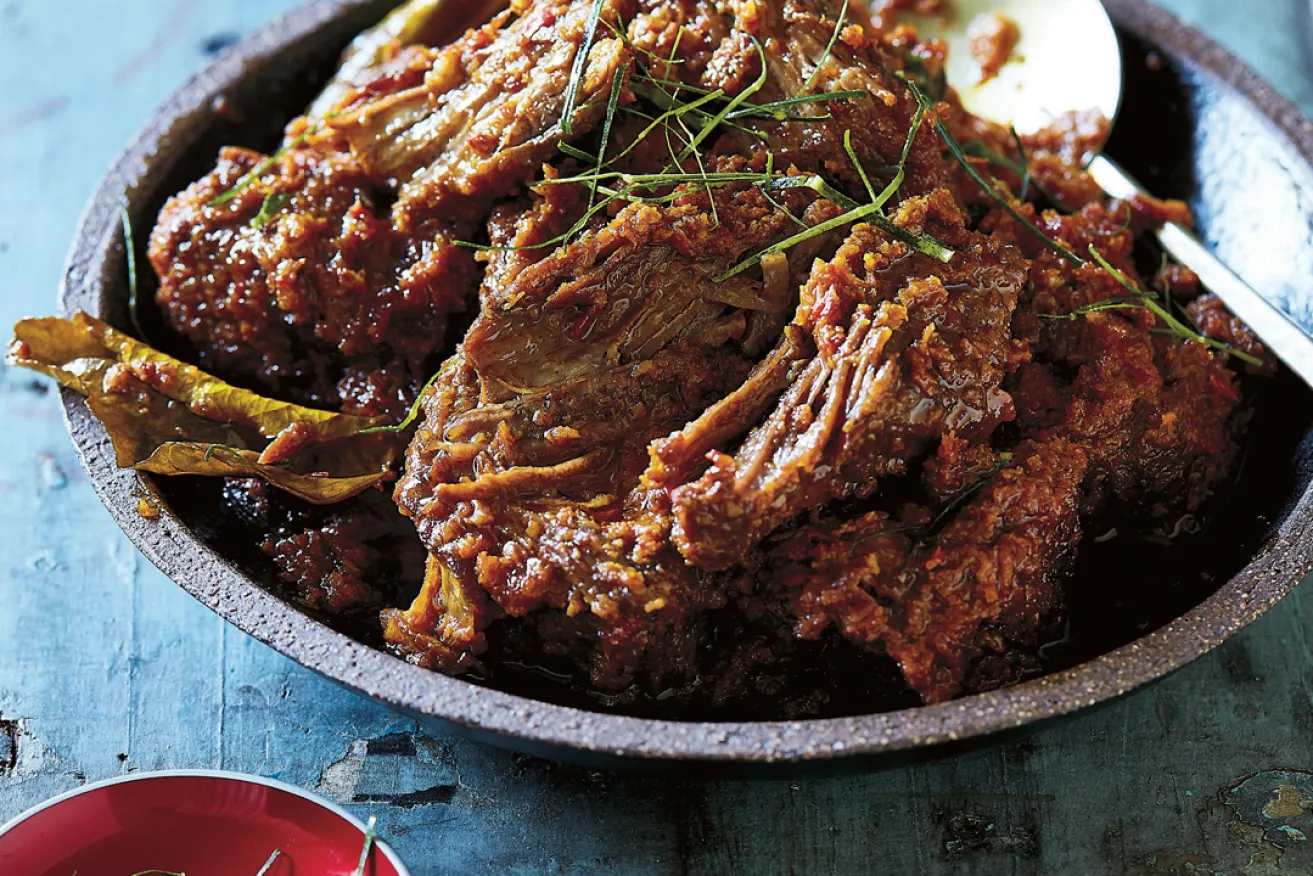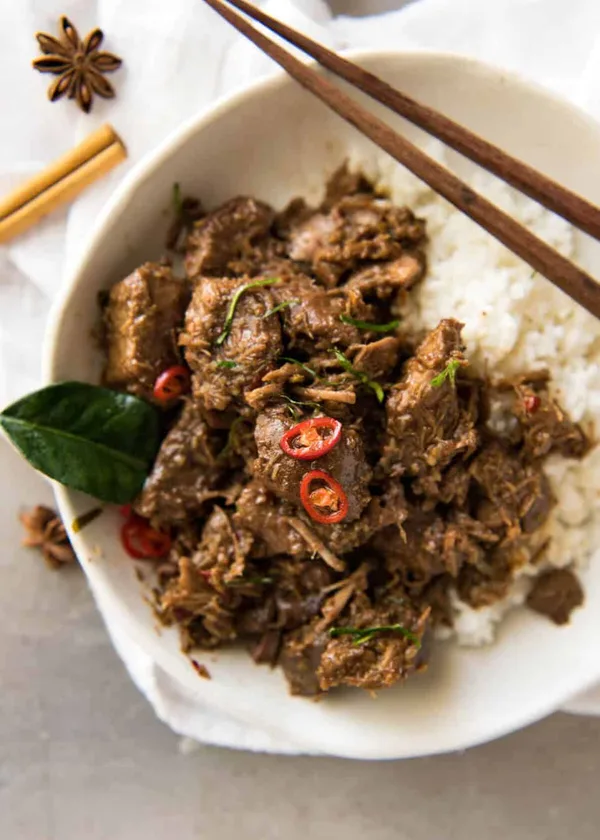A Google doodle - rendang
- rosemary
- Aug 22, 2024
- 5 min read
Updated: Sep 29, 2024

I now know that this is a Google doodle, and you can browse their collection of doodles at that link. Loved their little humorous digs at some of the more unusual Olympic events. They brighten your day just a tiny bit when you turn on your computer..
So yesterday as I began my daily Google searches, there was the above doodle. It was obviously food, but I got no further than that, so I hovered over it, as one does, and found that it was rendang, so I saved the picture. Today, somehow or other - probably just by googling, I got to that Google doodles page where I found some information that I had not known about rendang:

"It’s officially recognized as a national dish of Indonesia and designated as an intangible cultural heritage by the Indonesian Ministry of Education and Culture. On this day, the West Sumatra governor received a trophy from the Indonesian Record Museum for the biggest rendang online cooking event of all time.
The origins of rendang date back to the 16th century. While the Minangkabau borrowed curry techniques like using lots of spice and coconut milk, they cooked the dish much longer until it thickened, making it less saucy."
(That picture is of a West Sumatran rendang cooking festival)
Who are the Minangkabau you may ask. Well according to Tony Tan they are a group of indigenous people in Western Sumatra, and indeed probably borrowed those curry techniques from India and Sri Lanka with whom they traded. He adds that:
"The Minangkabau are best known for three cultural traditions: their society is matrilineal; they practise a form of migration called merantau, whereby men are encouraged to move away to earn their fortune; and they are well known throughout Indonesia for their cooking." Tony Tan
When you look for recipes for rendang you will find that almost all of them say that it is a Malaysian dish, and, indeed it is very popular there, and in Singapore, but it's really from Indonesia - and that specific part of Indonesia - it's just that some of those Minangkabau men must have have migrated to Malaysia to seek their fortune and took their rendang with them.

The reason I was so taken with this particular Google doodle was that it reminded me of an occasion long, long ago when I made Charmaine Solomon's Rendang daging at a time when my parents were visiting from England, and I remember my mother saying that she thought she even preferred it to Indian curries - which she loved. And I may have thought so too. However, I haven't made it for years, even though I sometimes think of how wonderful it was. Probably because of David's professed dislike of coconut.
It is indeed a very popular dish and:
"when CNN Travel polled its readers in 2011 to come up with a list of the world’s 50 most popular dishes, beef rendang came in at number one, ahead of Peking duck, lasagne, sushi and pad Thai." Tony Tan
The result would probably be different today, but nevertheless ...
So what is it? Well it's a curry like dish - most usually beef - or water buffalo in its native country - although today versions exist for chicken, lamb, even kangaroo and vegan and vegetarian versions. The flavours are coconut and chilli, ginger and other spices, but the main thing that differentiates it from its relatives is that the meat is not fried at the beginning of the cooking process (though Nagi Maehashi prefers to do that), but at the end, after the sauce has all but disappeared during the hours of long slow cooking.
"If the science of cooking interests you, in this meat dish the Maillard reaction comes at the end, not the beginning. That is, you don’t brown the meat at the start, but caramelise it at the end." Kummerspeck
Mind you if you prefer a bit of sauce, you can stop the cooking at an earlier stage when there is still some sauce clinging to the meat - and then you call it Kaliyo:
"almost a sister to rendang is kaliyo. It is exactly the same dish, only in a slightly earlier stage of preparation when the meat still has nicely thickened sauce clinging to it. I love rendang, but I have a passion for kaliyo" Madhur Jaffrey
There is, of course, no 'authentic' recipe for this dish. Everyone has their own version. I would highly recommend the Charmaine Solomon version, but here are a few Australian/Asian recipes to compare. Adam Liaw has two - well his Rendang terlagi-lagi is a rather faster and rather different thing I suppose - there are fewer spices and the coconut is in a different form, but he also has his 'home' recipe for Beef rendang of which he says:
"It is my very strong belief that rendang should be made with very few dried spices (if any). I know many recipes use cumin and coriander etc. but I think it’s best to have the fragrance be defined by fresh aromatics like galangal, ginger, turmeric, fresh chillies, lemongrass, makrut lime, and the coconut of course. It’s a coconut stew rather than a “curry.” I do add star anise and cassia bark, but that’s it for dried spices." Adam Liaw
The two pictures on the right are fundamentally the same dish, but I think using different cuts of beef.
Then there are three other Asian Australians offerings: Beef Randang - Tony Tan/Gourmet Traveller; Beef Rendang - Nagi Maehashi/Recipe Tin Eats and Poh Ling Yeow who provided a recipe for Red Rock Deli, on which to base yet another iteration of their packets of chips - Malaysian Beef Rendang
Long and slow, but lots of these experts said not suitable for a slow cooker if you have one of them, because it has to be dry. Mind you there are plenty of slow cooker recipes out there. Maybe they should call them Kaliyo. So you need time because you have to keep an eye on it and make sure it doesn't burn, but I did it way back then, so it's possible and I might have a go again sometime soon.
POSTSCRIPT
No samosas with the leftover chicken. David thought the chicken had made him a bit queasy, so against my better judgement I threw it into the council green bin. It was a cheese and onion quiche instead - oh that included pickled onions, cornichons, mustard and lots of cheese, less cream. It was pretty nice. Cooked the onions first with some salami and bacon.
Those long ago years - August 22
2021 - Nothing
2020 - Where are the peanuts?
2017 - Nothing
2016 - When is a sardine a sardine?













Comments